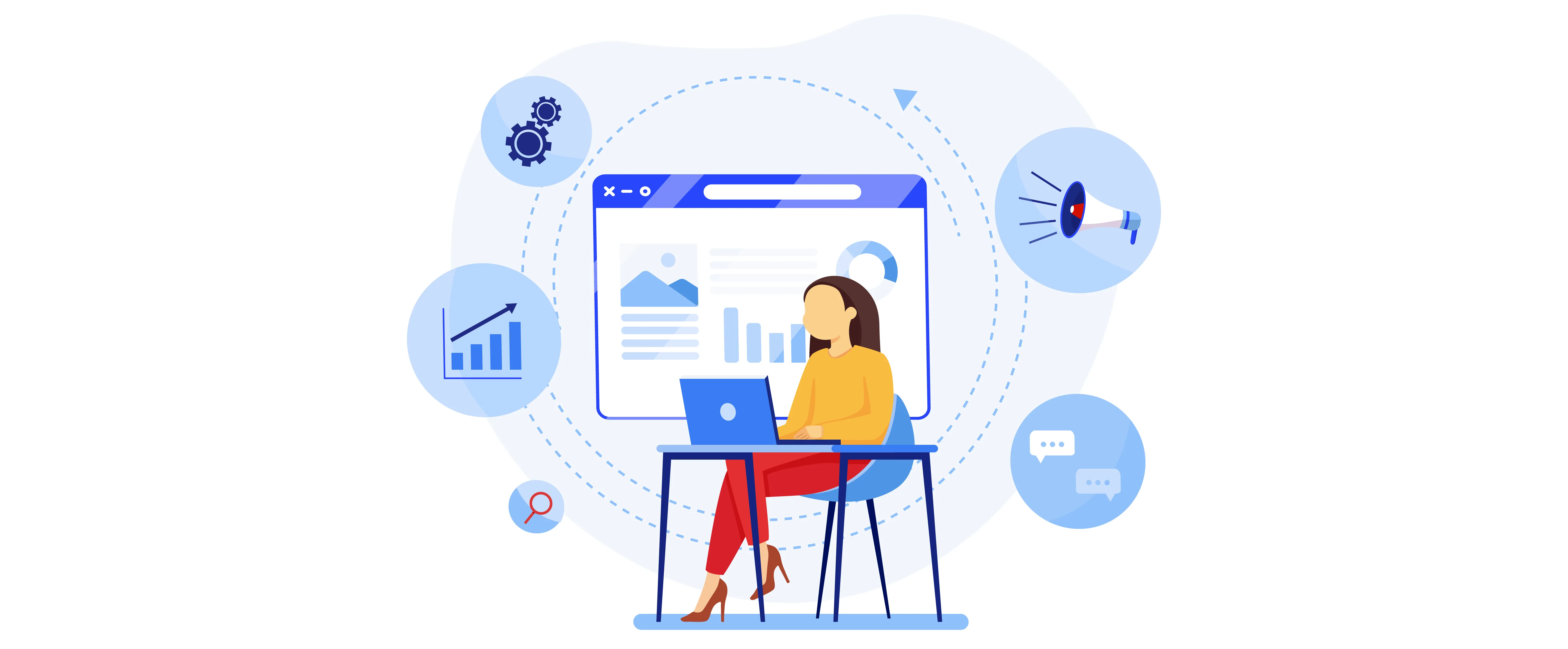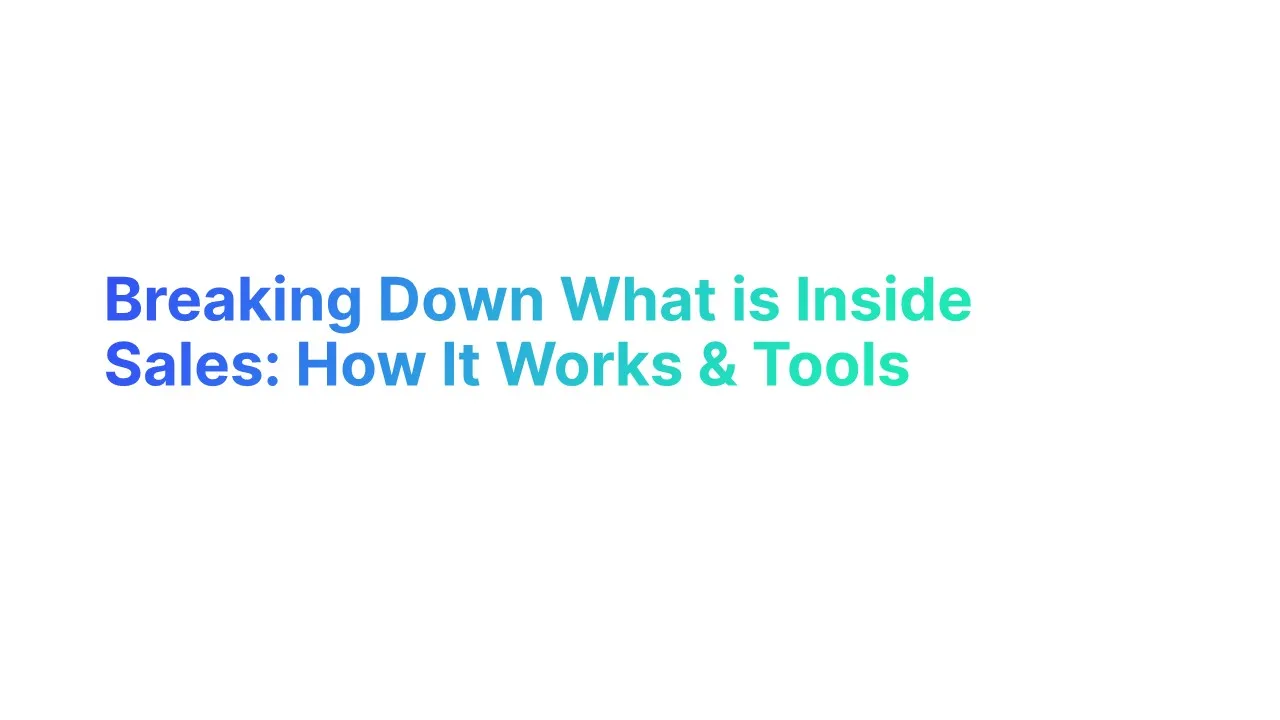What is Inside Sales?

Inside Sales refers to the process of selling products or services remotely, using technology such as email, phone, and virtual meeting platforms, rather than face-to-face interactions.
Examples of Inside Sales:
- Software Sales: A company selling SaaS products may use inside sales teams to handle inquiries, provide demonstrations via screen sharing, and close deals over the phone or through webinars.
- Telecommunications: Inside sales representatives at telecom companies might reach out to potential customers to discuss plans, offer upgrades, and negotiate contracts.
Benefits of Inside Sales

Inside sales offers several distinct advantages that can enhance business efficiency and profitability:
- Cost Efficiency: Operating costs for inside sales are generally lower than for outside sales. No travel expenses mean companies can allocate funds to other aspects of sales like training or technology. For example, companies report saving an average of 50-60% in costs when switching from outside to inside sales strategies.
- Scalability: Inside sales models are easier to scale. This scalability comes from the ability to quickly onboard new employees without the need for extensive field training or travel logistics.
- Increased Productivity: Inside sales reps can handle multiple calls and emails a day, far exceeding the number of face-to-face meetings outside sales reps can achieve. Data suggests that inside sales reps can increase touchpoints by up to 40% compared to their outside counterparts.
- Better Lead Management: With advanced CRM systems, inside sales teams can more efficiently track interactions, manage follow-ups, and optimize sales funnels. This systematic approach results in conversion rates improving by an average of 25%.
- Wider Geographic Reach: Inside sales teams are not limited by geographical constraints. They can connect with potential customers across different regions and time zones, significantly expanding the market reach.
- Enhanced Data Collection and Analysis: Inside sales allow for the integration of sales calls with CRM tools, which provides valuable data on customer behavior, preferences, and sales effectiveness. Companies utilizing these analytics report a 15-20% increase in sales efficiency.
What is Outside Sales
Outside sales refers to the traditional method of selling products or services where sales representatives meet prospects and clients face-to-face outside their company premises. This approach is also known as field sales or door-to-door sales, depending on the context.
Inside Sales vs Outside Sales
What Do Inside Sales Representatives Do
Inside sales representatives play a crucial role in modern sales operations, especially in industries where quick communication via digital channels is advantageous.
They connect with clients remotely, using various communication tools to engage, inform, and close sales.
Daily Responsibilities:
Client Interaction:
- Engage with potential clients through calls, emails, and video conferences.
- Identify customer needs and provide appropriate product solutions.
- Offer product demonstrations virtually to illustrate features and benefits.
Sales Pipeline Management:
- Nurture leads through the sales pipeline from initial contact to closing.
- Utilize CRM software to track interactions, manage follow-ups, and maintain customer data.
- Analyze the sales funnel to optimize conversion rates.
Sales Execution:
Deal Closure:
- Negotiate terms and close deals, often involving multiple stakeholders.
- Overcome objections with well-prepared responses and reassurances.
Performance Tracking:
- Regularly review performance metrics to gauge success and identify areas for improvement.
- Adjust sales strategies based on real-time feedback and market trends.
Collaboration and Training:
Team Collaboration:
- Work closely with marketing and product teams to align on strategies and messaging.
- Participate in regular training sessions to stay updated on product features and sales techniques.
Customer Feedback and Retention:
- Follow up with customers post-sale to ensure satisfaction and foster long-term relationships.
- Gather and relay customer feedback to the product team to help in future developments or improvements.
Inside Sales Process

1. Lead Generation:
- The first step in the inside sales process involves identifying and gathering potential leads. This can be achieved through various channels such as digital marketing, social media campaigns, webinars, content marketing, and cold calling.
- Effective lead generation also involves SEO strategies to attract traffic to the company's website, where potential clients can fill out contact forms that capture their details into the CRM system.
2. Lead Qualification:
- Once leads are generated, they must be qualified to ensure they are a good fit for the company's products or services. This involves assessing the lead's budget, authority, needs, and timeline (BANT criteria).
- Inside sales reps often use lead scoring systems integrated within CRM tools to prioritize leads based on their likelihood to convert, focusing their efforts more efficiently.
3. Initial Contact:
- After qualifying a lead, inside sales representatives reach out via email or phone. This step is critical as it sets the tone for the relationship. The initial contact aims to establish rapport and gauge the lead’s interest in the product or service.
- Personalized emails or calls that reference specific details about the lead's needs or past interactions can increase engagement rates.
4. Lead Nurturing:
- Not all leads will convert on the first contact. Lead nurturing involves maintaining contact with leads through educational and informative content, regular updates about new features or offers, and continuous engagement via newsletters or targeted emails.
- This phase keeps the potential customer engaged and informed, gradually pushing them down the sales funnel.
5. Presentation and Demonstration:
- For more interested leads, the representative will schedule a demonstration or detailed presentation of the product or service. This is often done through video conferencing tools where features can be demonstrated live, or through pre-recorded videos that highlight key functionalities.
- The goal here is to tailor the presentation to the specific needs and pain points of the potential customer, showing how the product or service provides the perfect solution.
6. Objection Handling:
- During or after presentations, potential customers may have objections or concerns. Inside sales reps need to be well-prepared to address these effectively. Training in objection handling and having ready access to detailed product knowledge is crucial.
- Handling objections adeptly can significantly increase the chances of moving forward to the closing stage.
7. Closing the Sale:
- If the customer's objections are satisfactorily addressed, the next step is to close the sale. This involves discussions about pricing, contracts, and terms of service.
- Efficient CRM systems streamline the closing process by automating proposals and contract management, allowing for electronic signing and immediate deal closure.
8. Post-Sale Follow-Up and Customer Retention:
- After closing the sale, inside sales representatives focus on customer retention through excellent after-sales service.
- Follow-ups to ensure customer satisfaction, addressing any post-sale concerns, and regular check-ins can foster loyalty and lead to repeat business or referrals.
10 Inside Sales Tools to Use

Inside sales teams rely on a variety of tools to streamline their processes, improve efficiency, and enhance customer engagement. Here are five essential inside sales tools that can significantly benefit any team:
1. HubSpot Sales
Features:
- CRM Integration: Centralizes customer information and interactions, providing a comprehensive view of sales pipelines.
- Email Tracking: Notifies reps when a prospect opens an email, helping to time follow-ups perfectly.
- Meeting Scheduler: Allows prospects to book meetings directly into a sales rep’s calendar, minimizing scheduling hassles.
Benefits:
- Improves efficiency through automation of routine tasks.
- Enhances customer interactions by providing timely and relevant communications.
2. Salesforce Sales Cloud
Features:
- Lead and Opportunity Management: Helps track all sales opportunities and leads from prospect to close.
- AI-powered Insights: Provides predictive analytics and trend analysis to help sales reps focus on the right opportunities.
- Customizable Dashboards: Offers personalized reports and views to monitor sales metrics.
Benefits:
- Offers extensive customization options to fit various business needs.
- Boosts decision-making with powerful data insights and forecasting tools.
3. ZoomInfo
Features:
- Prospect Intelligence: Provides detailed profiles and contact information for millions of business professionals and companies.
- Lead Enrichment: Enhances existing customer data with up-to-date information, ensuring accuracy.
- Sales Automation: Streamlines prospecting tasks to increase the number of touchpoints.
Benefits:
- Accelerates lead generation by providing actionable and detailed prospect data.
- Enhances the accuracy of sales campaigns with enriched data.
4. Yesware
Features:
- Email Templates: Offers customizable templates for various stages of the sales process.
- Tracking: Monitors email open and response rates, attachment opens, and presentation pageviews.
- Sales Campaigns: Enables reps to run multi-touch email campaigns directly from their inbox.
Benefits:
- Saves time with ready-to-use email templates.
- Provides real-time feedback on email effectiveness, helping refine sales strategies.
5. Outreach
Features:
- Sequence Automation: Automates the process of reaching out to prospects with personalized messages across various channels.
- A/B Testing: Tests different messages to see what works best with different segments.
- Analytics Dashboard: Tracks the performance of sales sequences and individual reps.
Benefits:
- Enhances productivity by automating routine communication tasks.
- Optimizes communication strategies with robust testing and analytics.
6. Pipedrive
Features:
- Visual Sales Pipeline: This tool offers a customizable pipeline that visually tracks different stages of the sales process, helping sales teams manage both inside and outside sales effectively.
- Activity Reminders: Automated reminders ensure follow-ups and sales meetings are never missed.
- Mobile App: Access to sales data and functionalities on the go, allowing reps to update and consult their pipelines anytime, enhancing their ability to close deals quickly.
Benefits:
- Helps organize and prioritize sales activities to improve engagement with existing customers and prospects.
- Ensures timely actions that are critical for maintaining customer relationship management and increasing conversion rates.
7. Zoho CRM
Features:
- Multichannel Communication: Supports seamless communication across email, phone, live chat, and social media within the CRM, ideal for managing diverse customer interactions in business to business environments.
- Sales Automation: Streamlines routine sales tasks, such as lead distribution and follow-up scheduling.
- Performance Analytics: Monitors sales trends and representative performance, crucial for strategic planning in sales positions.
Benefits:
- Provides a holistic platform for managing all aspects of customer relationships and inside sales.
- Enhances efficiency through automation, providing more time for reps to focus on closing sales and generating revenue.
8. Calendly
Features:
- Automated Scheduling: Simplifies the meeting booking process, integrating with personal and professional calendars to prevent conflicts.
- Time Zone Intelligence: Automatically adjusts for different time zones, facilitating easier coordination of sales meetings.
- Customizable Time Slots: Ensures sales reps can manage their availability, optimizing their schedules for peak performance.
Benefits:
- Reduces the administrative tasks associated with scheduling, enabling reps to focus more on sales activities.
- Improves customer experience by making it straightforward for prospects and existing customers to book meetings.
9. Freshsales by Freshworks
Features:
- AI-based Lead Scoring: Automatically scores leads based on their interactions and potential to close, which is especially useful in prioritizing efforts towards high-value business to business opportunities.
- Email Tracking and Templates: Provides real-time data on email performance and customizable templates for rapid communication.
- Sales Campaigns: Allows for the creation and tracking of targeted email campaigns, measuring their effectiveness in real-time.
Benefits:
- Sharpens lead management with advanced scoring, improving the focus on more promising leads.
- Boosts outreach effectiveness through sophisticated campaign tools and analytics, leading to more successful closing sales.
10. Leadfeeder
Features:
- Website Visitor Tracking: Identifies companies that visit your site, detailing how they found you and what they’re interested in—a powerful tool for generating leads in outside sales.
- CRM Integration: Enhances existing customer profiles in the CRM with additional data gleaned from website interactions.
- Custom Feeds and Filters: Customizable monitoring options allow teams to track visitor behavior based on specified criteria, facilitating targeted engagement.
Benefits:
- Reveals potential leads by identifying anonymous website visitors, which is crucial for developing new business opportunities.
- Enables more precise lead qualification with detailed insights into visitor behaviors, enhancing strategies for both inside and outside sales teams.
How Do Inside Sales Differ in B2B and B2C
How to Optimize Your Inside Sales Pipeline
Optimizing an inside sales pipeline is crucial for maximizing efficiency and increasing sales conversions. An effective sales pipeline not only streamlines the sales process but also provides clear visibility into your sales activities, allowing you to make data-driven decisions. Here are key strategies to help you optimize your inside sales pipeline:
1. Define Clear Stages
- Set Specific Criteria: Establish clear criteria for each stage of your pipeline, from initial contact to closing. This clarity helps reps understand exactly what needs to be accomplished to move a prospect to the next stage.
- Streamline Stages: Simplify the pipeline by eliminating unnecessary steps that do not add value to your sales process.
2. Implement Effective Lead Scoring
- Prioritize Leads: Use lead scoring to prioritize leads based on their likelihood to convert and their potential value to the business. This approach ensures that your team focuses their efforts on the most promising leads.
- Adjust Scores Based on Data: Continuously refine your scoring criteria based on the outcomes and feedback to improve accuracy over time.
3. Leverage Automation Tools
- Automate Routine Tasks: Use CRM tools and sales automation software to handle repetitive tasks such as data entry, lead assignment, and initial follow-up emails.
- Enhance Engagement: Automation tools can also help schedule calls and set reminders for follow-ups, ensuring that no leads fall through the cracks.
4. Regular Training and Development
- Skill Enhancement: Regularly train your sales team on best practices for engaging leads, advancing them through the pipeline, and closing sales. This training should include handling objections, negotiation tactics, and the use of technological tools.
- Feedback Loop: Encourage a culture of feedback where sales representatives can share insights and challenges, which can be used to refine strategies and processes.
5. Monitor and Analyze Performance
- Key Metrics: Regularly track and analyze key performance indicators (KPIs) such as conversion rates, average deal size, and sales cycle length. This data helps identify bottlenecks and areas for improvement.
- Adapt Strategies: Use insights from performance data to make informed adjustments to your sales process, focusing on areas that will drive the most improvement in efficiency and outcomes.
6. Enhance Customer Engagement
- Personalize Interactions: Tailor communications to meet the specific needs and interests of each prospect. Personalization can significantly increase engagement and move leads more effectively through the pipeline.
- Utilize Multi-Channel Communication: Engage with prospects across multiple platforms such as email, phone, and social media to increase touchpoints and build stronger relationships.
7. Focus on Continuous Improvement
- Iterative Process: Treat pipeline optimization as an ongoing process. Continuously look for new ways to improve your sales strategies and pipeline management based on evolving market conditions and customer feedback.
- Technology Updates: Stay updated with the latest sales technologies and tools that can enhance pipeline efficiency and effectiveness.
Concluding Thoughts for Inside vs Outside Sales
Inside sales has become a critical component of modern business strategies, empowering companies to reach wider markets and streamline their sales processes. As we've explored, the role of an inside sales representative is multifaceted, encompassing everything from lead generation to closing sales through virtual interactions. These professionals hold a sales position that demands a high level of skill in digital communication and customer engagement.
Unlike roles that focus on outside sales, the salary and compensation structures in inside sales may differ due to the lack of travel and face-to-face interactions, yet the potential for earning remains robust due to scalability and efficiency gains. Understanding both the nuances of inside sales and the tools that enhance these operations can significantly benefit companies looking to thrive in an increasingly digital marketplace.





.jpg)

.jpg)
